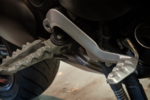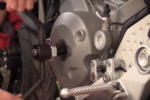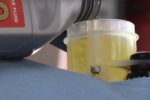We’ve probably all heard “if you have a $10 head, buy a $10 helmet” – I believe Bell Helmets even used that as their advertising campaign. But the Motorcycle Safety Foundation says that as long as helmet meets DOT standards it’s going to provide the same level of protection regardless of price point. So is there any reason to purchase a very expensive helmet? We really do not have the ability to answer these huge philosophical questions as they pertain to safety. But what we have done is obtain what has consistently been considered as the premium, highest high-end motorcycle helmet available and asked: “is it worth the price tag”?

The helmet in question, the Arai RX-7 Corsair (a new version of the RX-7, the RR5, will be available in late 2008 – early 2009). Manufacturers Suggested Retail Price for the cheapest iteration of this helmet (solid white) is $610. Step up to a fancy race replica paint scheme and the price climbs to $815! So, is an Arai worth that price tag?
Why Arai?
Arai was founded in 1926 by hat maker Hirotake Arai. Hirotake was what you would call a “motorcycle nut” and started making motorcycle helmets more than 50 years ago. Today, Michio “Mitch” Arai, another motorcycle nut, runs the company. And his son, Akihito, is now the third generation moto-nut and is expected to follow in his families footsteps.
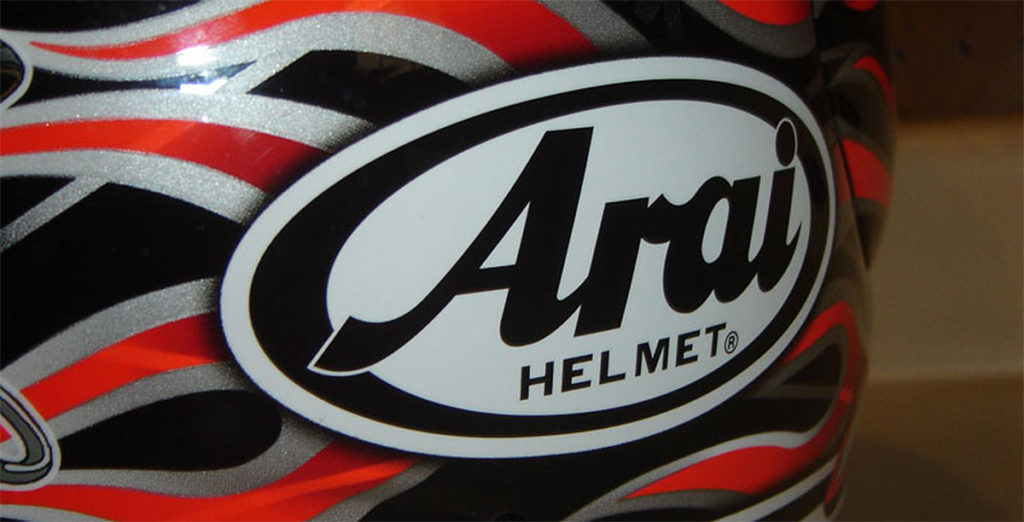
Every Arai helmet is virtually 100% handmade. Each builder signs the helmet shell and every helmet is hand inspected at least three times during construction. Arai claims that every helmet model is held to the exact same quality standard; “comfort, fit, finish, quality and safety are not compromised to fit a cheaper pre-determined retail price to please shareholders or to squeeze under the barest minimum of safety standards”.
As a result, Arai has been rated first in customer satisfaction in every single J. D. Power and Associates Motorcycle Helmet Satisfaction Study. In 2008, for example, Shoei was the only helmet to rate close to the dominant Arai.
How Good is it, Really?
To start off, we got the Haga Fire and Ice replica (MSRP $725) and our first impression was, quite simply, “wow”. The quality of the finish is absolutely brilliant! Thick, rich clearcoat over the painted surfaces gives the helmet a gorgeous deep, shine and the saturation of the red colors was thick and rich. Without even touching the helmet it oozes with the look of quality and attention to detail. This is easily the prettiest helmet we’ve ever sampled, including past “lower” Arai models such as the Arai Profile and Quantum II.

The only flaws we found in the helmet’s aesthetics was the slight misalignment in paint lines between the side-pods and the intake scoops on the top of the helmet. With the case of our helmet, these misalignments were very slight and did not detract from the helmets overall beauty.
Picking the helmet up we were surprised by how light it felt. Arai uses a patented SNC (Structural Net Composite) shell construction that uses structural net reinforcing material, embedded between their Super Complex Laminated Construction layers that they claim improves resistance to shearing forces while also allowing for more weight to be removed from the top of the shell. This is done to reduce overall helmet weight and improve the center of gravity making the helmet feel much lighter more comfortable to the wearer without compromising functionality.
One of the things we learned about Arai that really impressed us was how the inner, impact absorbing liner is constructed. From what we were told, Arai is the only company using a one-piece liner. Most other helmet manufacturers use different densities of EPS glued together and then fitted inside the shell of the helmet. Arai uses a “single piece hybrid liner” where each EPS cell is fused to its neighboring cell. EPS cells of varying densities are placed in different locations within the liner so that each part of the EPS liner can be varying densities and as one is crushed under impact, the surrounding cells assist with the energy absorption.
Arai has gotten a lot of guff about the side-pods. Arai says the reason why they still use them is that the pods allow the helmet to maintain a more aerodynamic shape while allowing the shell and EPS thickness to remain the same on the side of the helmet, rather than be made thinner (or denser) to allow the visor to mount flush with the shell.
How Does it Work?
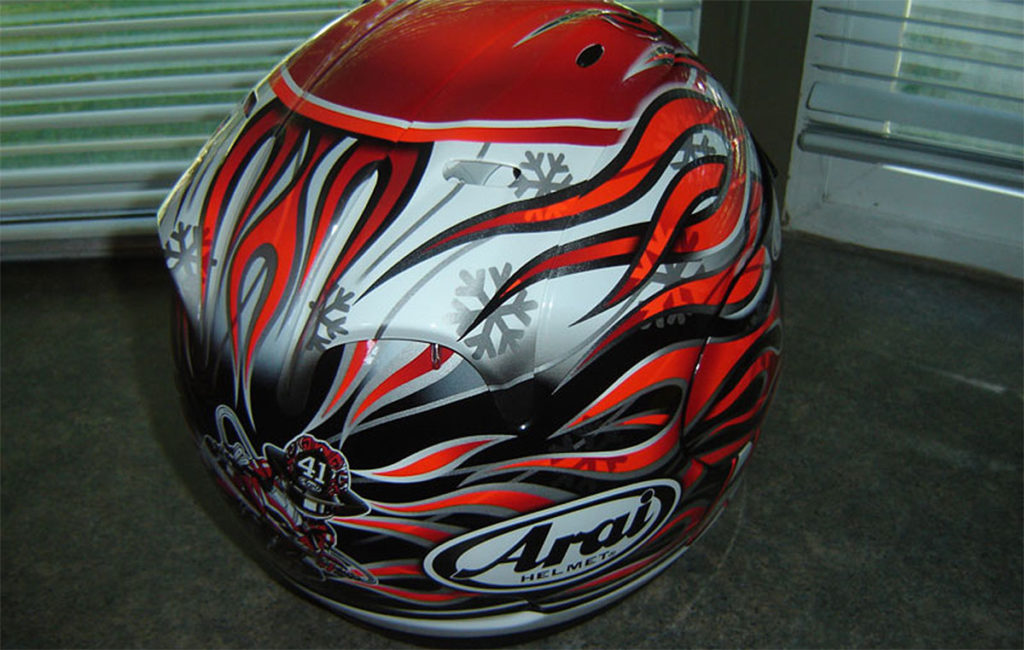
Venting
Slipping the helmet on, it fit perfectly and again, felt very light. So light in fact, that it was easy to forget the helmet was even on my head. As soon as I started rolling a trickle of cool air could be felt on top of my noggin. Arai’s work with Formula 1 car racing taught them that the best way to make a helmet cooler is to draw hot, stale air out of the back of the helmet, rather than try to force cool air in. The cool looking ducts on top of the helmet have 1 intake scoop and three exhaust ports that work to draw air out. Without air moving out, cool air cannot move in.
We’ve had a lot of helmets that claim to have exceptional venting, but so far the RX-7 is the only one where I could actually feel air moving around the top of my head. A feature that is very important for us living in a hot-arid desert. Additionally, the vents were easily opened and closed with gloved hands while on the move. Our first complaint about the helmet is over the vents, however. The center roof vent is clear plastic and it quickly filled up with dead bugs and gunk – even after just one ride. To keep it looking nice we needed to use a q-tip and a great deal of patience to carefully extract the grime. Painted scoops would look better and require less cleaning.
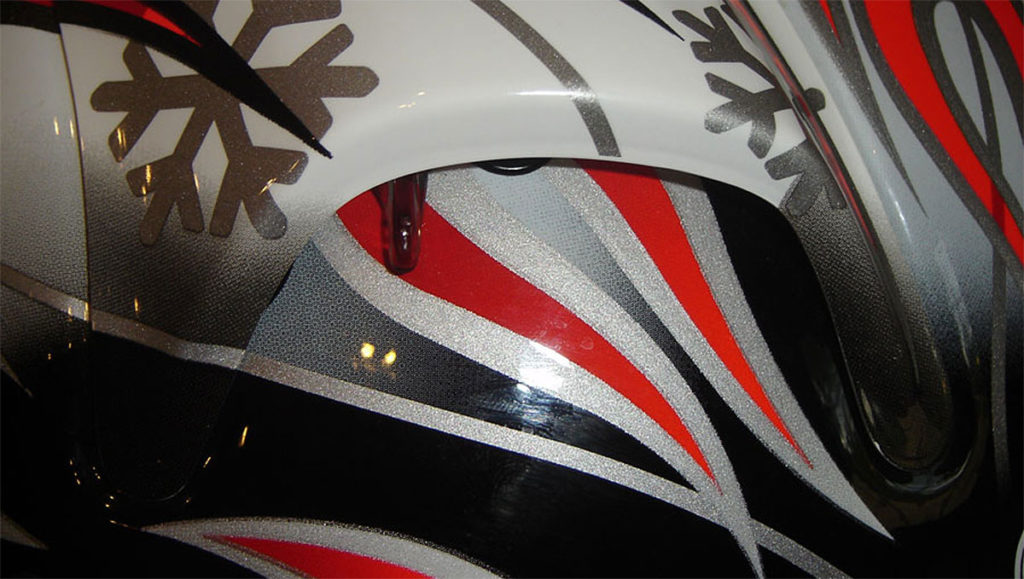
Noise
We did notice that the helmet was quite loud. This surprised us as the helmet has gotten such high marks for being quiet. A quick call to our Arai guy and we were told that the visor probably just needed to be adjusted. To do this we were to remove the visor, then using a flat object like a butter knife, reach in and press on the red button located behind the plastic side-pod. When we pressed the red button, the painted side-pod popped off and we found ourselves looking at the visor ratchet mechanism. Just as our Arai guy said, there were two flat head, plastic screw holding the ratchet mechanism to the helmet. We snapped the visor back onto the helmet (with the side-pods still removed) and loosened the four screws and slid the ratchet mechanism towards the back of the helmet drawing the visor closer to helmet. In essence, we basically repositioned the visor to remove any gaps between it and the helmet.
The side-pods snapped back on and we went out for another ride. Sure enough, the helmet was significantly quieter! Since we normally ride with ear-plugs, noise isn’t as high of a concern for us, but with the visor properly adjusted it was pleasantly quiet. So our second complaint about the helmet is that the visor was not properly adjusted when we got the helmet. Three inspections during the construction and you’d think the visor would have been adjusted.
Swapping Visors
Another complaint with the Arai was how difficult it seemed to be to remove the visor. Other helmets it seemed like the visor could be snapped on and off in a matter of seconds, yet removing and replacing the visor on the Arai felt like we were going to break something. So another call to our Arai guy for some quick visor replacement training. He told us that the Arai visor replacement system is the most misunderstood on the planet, and then showed us how you can swap visors while still wearing the helmet! And yes, it can be done! Check out this YouTube Video.
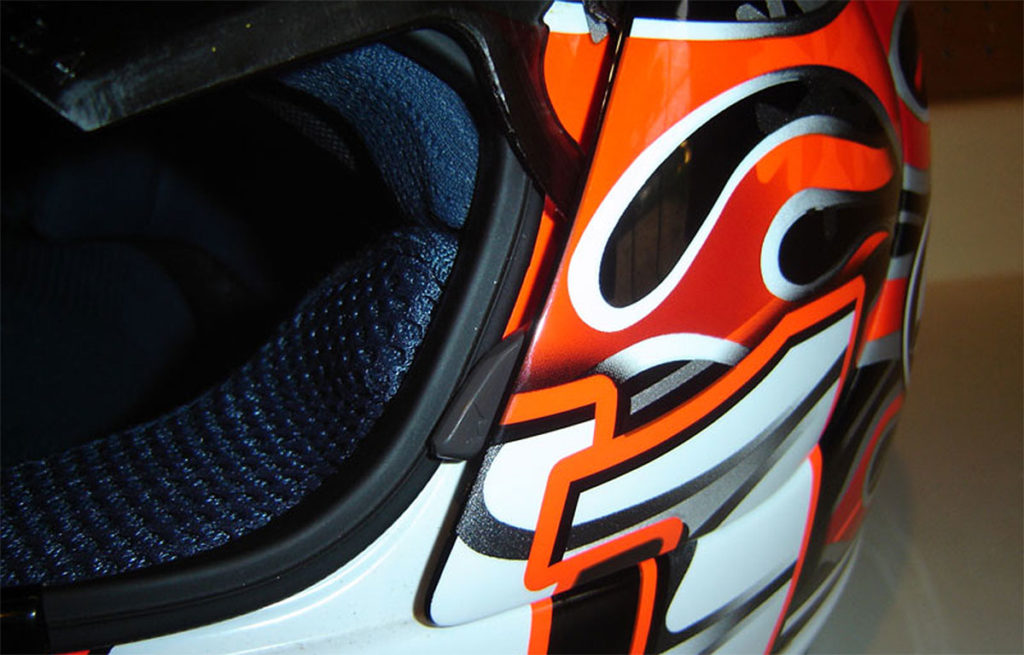
When you open the visor all the way, two gray buttons emerge at the front of the side-pods. Rotate the gray buttons up and release them while rotating the visor up beyond the full-open position. Suddenly the visor is free from the helmet. To put the new visor back in, holding the visor in the open position, simply insert the edges between the side-pods and the helmet until it stops and gently rotate the visor closed. If everything is done right, it simply locks back into place and off you go. After a little bit of practice and training, we now think its one of the easiest visors to change out and we can impress our friends when we switch from a tinted visor to a clear visor without removing the helmet.
Comfort
It sure felt good pulling this helmet onto my head. Even on super-hot days where everything felt hot and sticky. Arai uses a “Dry-Cool” liner material, with a perforated satin feel. They say it uses water cells to improve moisture and heat transfer from your head into the airflow around Arai’s liner. The padding from the forehead, circling all the way around my cranium felt plush and comforting even after four days of consistent helmet use. Thick, lush cheek-pads made it impossible to chew gum but also held the helmet securely despite how fast I traveled (on the race track of course) and how much wind buffeting I experienced. I also noticed during extreme buffeting or bumpy conditions I could actually see more clearly. Our Arai guys told us that a properly fitting Arai helmet will help stabilize the ocular nerve. We don’t know how exactly since the liner allows for the insertion of sunglasses and we think that we would interfere with ocular nerve stabilization – but I did indeed notice things stayed clearer.
Conclusion
So there you have it, two and a half complaints about the helmet. Two and a half very minor complaints, but we were trying to be honest. However, we still haven’t answered the original question. Is it worth $800? The answer to that relies on your own personal budget. But a quick internet search and we were able to find these helmets selling for closer to $650 and our local Arai dealer said he could come really close to online prices. With that slightly lower price-tag, the helmet becomes dramatically more appealing! And as long as you are not a regular crasher, $650 works out to about $130 a year over five years (Arai helmets are designed to last five years from when they are put into service).
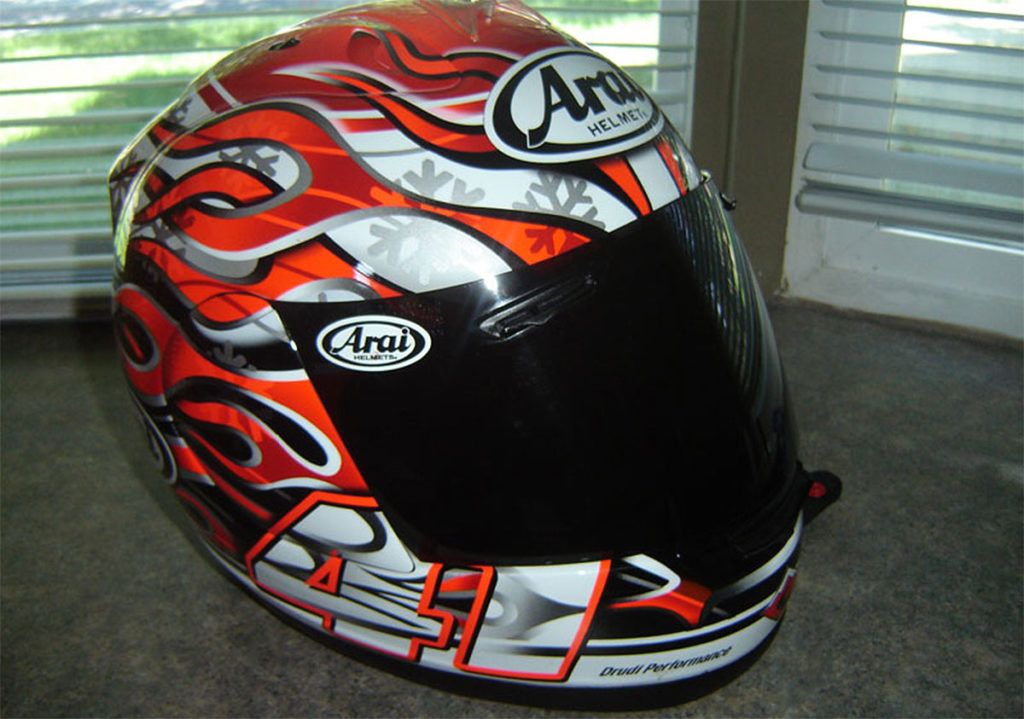
What we will say about the helmets overall worth is this; I quickly fell in love with mine. It was so comfortable to wear, I really enjoyed and looked forward to putting it on. The awesome paint quality made it kinda like head jewelry. I most definitely felt I looked a lot better with the helmet on (and the dark tint visor closed) than with it off. Also, because of the glorious look and feel of the helmet, I had a real sense that the helmet was made by someone who really cared about their work (remember Arai says these things are almost entirely hand-made). The attention to detail in the construction that I could see and touch honestly made me feel like the helmet was safer because surely that same attention to detail must have been put into the design and construction – the stuff I could not see or touch.
I never once questioned the helmets ability to protect my brain if I were to auger into the tarmac, so one must ask; what is peace of mind worth? Will you enjoy the ride more if you feel like you are safer while doing it? Personally, I put a lot of value on peace of mind and the quality of this helmet, exceeding the quality of any other helmet that’s passed through our hands, gave me a lot of reassurance and I’ll tell you what; I’m going to have a hard time putting anything less than an RX-7 on my head from here on out.




